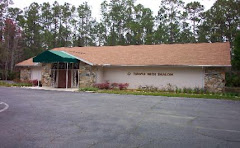
Daytona News-Journal Columnist Pierre Tristam to be featured guest at January 18th Temple Beth Shalom Men’s Club Breakfast
Pierre Tristam 2008 First Place Winner for Editorial Writing, from the Florida Press Club will be the guest speaker at a January 18th Temple Beth Shalom Breakfast at the synagogue beginning at 10 a.m. All are welcome. For adults age 13 and older the suggested donation is $12, children are admitted for free.
Pierre Tristam is a journalist, writer, editor and lecturer. He's been a member of the editorial board at the Daytona Beach, Fla., News-Journal since 2001.
Experience:
A native of Beirut, Lebanon, who became an American citizen in 1986, Pierre is one of the United States' only Arab Americans with a regular current affairs column in a mainstream, metropolitan newspaper. The column focuses on the Middle East, foreign affairs, civil liberties, immigration and federal politics.
Pierre's work has been published in numerous newspapers and magazines in the United States and overseas. Since 1991 Pierre has collected 13 first-place awards from various state and regional professional press associations for magazine, column, editorial and commentary writing.
Education:
Pierre is a graduate of the United Nations International School in New York and holds a B.A. in politics and history from New York University.
Pierre Tristam himself says that “I started trying to explain the Middle East in all its glories and follies, mostly to myself, while trailing in my mother's footsteps when she was a reporter during the Lebanese civil war. I don't think I've stopped. To say that what goes on in the Middle East affects lives in every time zone is trite, but still true: The region that once was the cradle of civilization now allegedly crackles with a clash of civilization that threatens all. I don't believe in the clash theory, nor in anxieties that the Middle East somehow holds the rest of the world hostage to its disquiet. What keeps various factions from getting along in the Middle East is what keeps many of us in the West from understanding the Middle East, and perhaps responding to its various seizures more wisely: some prejudice, a great deal of misunderstanding, and that old stand-by of all things irrational: fear. A little well-tempered myth-busting can go a long way.”
AWARDS
2008 First Place, Editorial Writing, Florida Press Club (large newspapers)
2007 First Place, Editorial Writing, Florida Society of Newspaper Editors.
2007 First Place, Commentary, Florida Press Club (large newspapers).
2007 First Place, Editorial Writing, Florida Press Club (large newspapers).
2007 First Place, Serious Column Writing, Florida Awards of Excellence (SPJ).
2007 Second Place, Editorial Writing, SPJ’s Sunshine State Awards (large newspapers).
2007 Third Place, Column Writing, Florida Society of Professional Journalists.
2007 Third Place, Editorial Writing, Florida Society of Professional Journalists.
2006 First Place, Commentary, Florida Press Club (large newspapers).
2006 Second Place, Editorial Writing, Florida Press Club (large newspapers).
2005 Honorable Mention, Editorials, Southern Newspaper Publishers Association.
2004 Third Place, Commentary, Florida Press Club (large newspapers).
2003 First Place, Editorial Writing, SPJ’s Sunshine State Awards (large newspapers).
2003 Second Place, Editorial Writing, Florida Society of Newspaper Editors.
2003 Third Place, Editorial Writing, Florida Press Club (large newspapers).
2003 Honorable Mention, Commentary, SPJ’s Sunshine State Awards (large newspapers).
2002 First Place, Commentary, Florida Press Club (large newspapers).
2002 First Place, Editorial Writing, Florida Press Club (large newspapers).
2002 Second Place, Editorial Writing, Florida Society of Newspaper Editors.
2001 First Place, Editorial Writing, Florida Society of Newspaper Editors.
2001 First Place, Magazine Writing, Society of Professional Journalists ( South Florida ).
2000 First Place, Commentary, Florida Society of Newspaper Editors.
1999 Second Place, Editorial Writing, Soc. of Professional Journalists (South Florida ).
1995-2001 Nominated for five Chairman's awards, New York Times Regional Group.
1995 Third Place, Best Written News Story, West Virginia Press Association.
1995 Third Place, Best Local Government Affairs Reporting, WVPA.
1993 First Place, Best Local Government Affairs Reporting, WVPA.
1992 First Place, Best Written News Story, WVPA.
1992-93 Three awards for Outstanding Editorial Achievement, Thomson Newspapers.
1991 First Place, Best Local Government Affairs Reporting, WVPA.
1991 Third Place, Best Written News Story, WVPA.
1989 Third Place, Enterprising Reporting, West Virginia Press Association.































